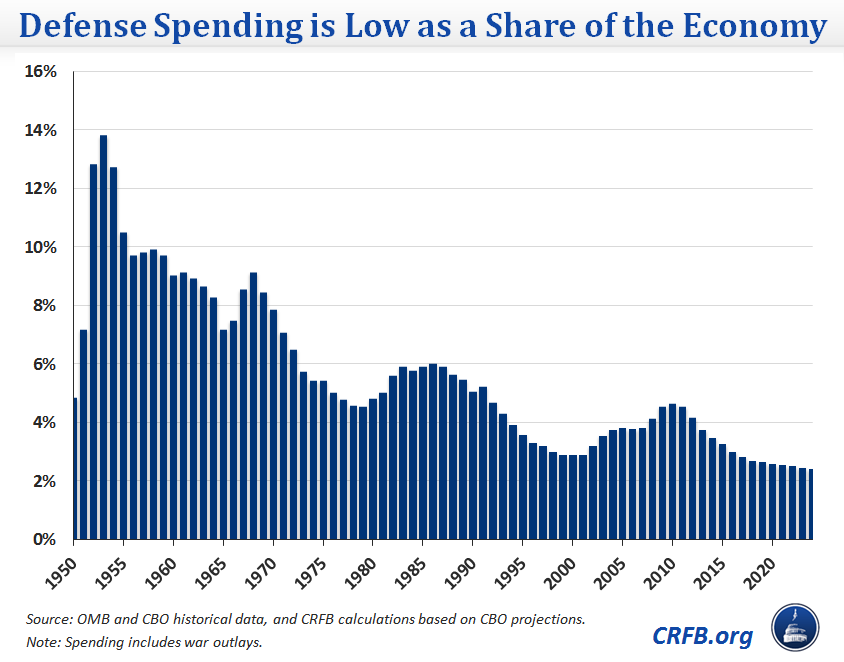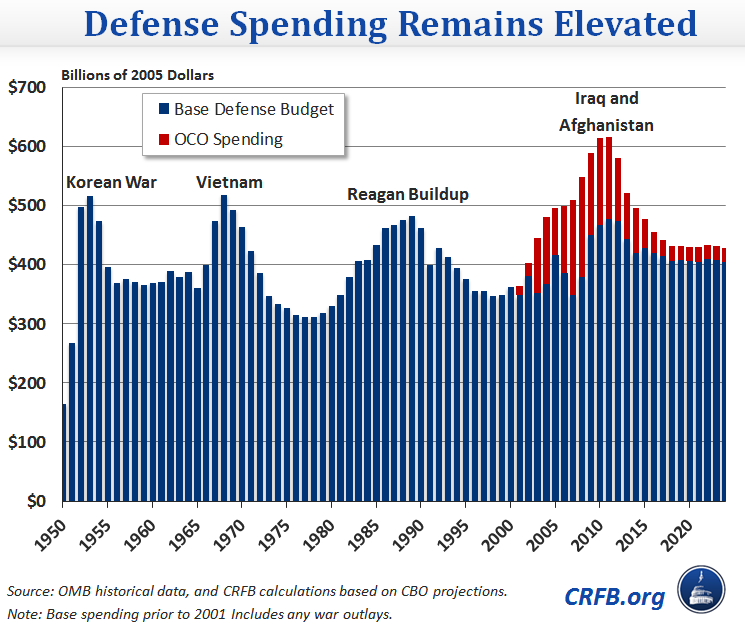Defense Department Trims Personnel Costs and Other Programs To Live Within Means
In a somewhat atypical move, Defense Secretary Chuck Hagel previewed in a speech yesterday the Department of Defense's (DoD's) budget request for FY2015, which will be a part of the President's Budget submitted to Congress next week. The budget shows the types of cuts necessary to comply with congressionally mandated budget cuts that transition DoD from an era of wars in Iraq and Afghanistan and real growth in the defense budget to a new era of discretionary spending restraint.
According to the Bipartisan Budget Act, defense spending next year is set to rise by $1 billion to $521 billion, which is lower than either party called for in their original budget proposals last year and represents $75 billion in cuts over this year and next compared to pre-sequester levels agreed to in the Budget Control Act.
While the President's Budget will abide by the agreed-upon spending levels for 2015, the President will propose five-year spending for the Defense Department that is $115 billion more than sequester levels. The budget will also propose an additional $26 billion of defense funding to be offset by cutting other spending and closing tax loopholes. Secretary Hagel argued that the increase strikes a balance between protecting national security and a realistic assessment of future fiscal levels, warning that "[s]equestration requires cuts so deep, so abrupt, so quickly, that we cannot shrink the size of our military fast enough."
Looking into the future, defense spending over the 2015-2024 period has been reduced by hundreds of billions of dollars as a result of several measures adopted over the past few years, including spending freezes, the Budget Control Act spending caps, and sequestration. As a result, defense spending will continue to fall as a share of the economy.
However, when looking at inflation-adjusted spending since World War II, defense spending will remain at historically elevated levels even after falling gradually over the next few years.
Hagel's speech illustrates the types of choices that DoD is making to simultaneously live within smaller future budgets and to modernize its force to fight more advanced adversaries.
The largest cost reductions proposed are in the growing area of personnel costs, which currently make up roughly 50 percent of DoD's budget. Hagel said, "Given the steps already taken to reduce civilian personnel costs – including a three-year pay freeze – no realistic effort to find further significant savings can avoid dealing with military compensation. That includes pay and benefits for active and retired troops, both direct and in-kind." (emphasis added) As shown recently by CBO, military personnel indeed does make up a large portion of DoD's budget and shows no signs of abating down the road.
The budget will propose a 13 percent reduction in the size of the active duty force and a 5 percent reduction in the size of National Guard and reserve units, while the number of Special Operations forces would increase by 6 percent.
Hagel stressed the need for holistic changes, and proposed reductions beyond trimming troop numbers. Civilian and military personnel will be limited to a 1 percent pay raise this year, while pay for generals and other top officers will be frozen. Servicemembers will gradually be asked to pay for 5 percent of their housing, rather than 0 percent today. The Defense Department will stop reimbursing for renters' insurance, and trim the direct subsidies given to military commissaries by $1 billion (over 70 percent).
Similar to last year, this year's budget recommends modernizing TRICARE, so servicemembers use the most affordable means of care, such as using generic drugs. The budget asks servicemembers to pay a little more in copays and deductibles, but Hagel assures servicemembers that "benefits will remain affordable and generous…as they should be."
However, the FY2015 budget does not recommend any changes to the military retirement system, which has been debated recently in Congress. (In December, Congress approved a 1 percentage point reduction in annual cost-of-living increases for working-age retirees. It undid the change for current servicemembers two months later.) No recommendations will be made until the Military Compensation and Retirement Modernization Commission completes its work, due to be presented in February 2015.
Hagel also called for several other reforms, including eliminating an entire class of Air Force attack jets that were scheduled to be replaced within a decade, as well as eliminating the U-2 spy plane. He called for a new round of base closures under the BRAC Commission (even though Congress has not agreed to BRAC requests for the last two years) and will announce cuts to bases in Europe, where BRAC authority is not needed. In the navy, Hagel will reduce the number of the new Littoral Combat Ships constructed from 52 to 32.
Hagel closed his discussion of military compensation by noting the necessity of reform:
"Although these recommendations do not cut anyone’s pay, I realize they will be controversial. Congress has taken some important steps in recent years to control the growth in compensation spending, but we must do more...Our proposals were carefully crafted to reform military compensation in a fair, responsible, and sustainable way. We recognize that no one serving our nation in uniform today is overpaid for what they do for our country. But if we continue on the current course without making these modest adjustments now, the choices will only grow more difficult and painful down the road. We will inevitably have to either cut into compensation even more deeply and abruptly, or we will have to deprive our men and women of the training and equipment they need to succeed in battle. But, either way, we would be breaking faith with our people. And the President and I will not allow that to happen."



